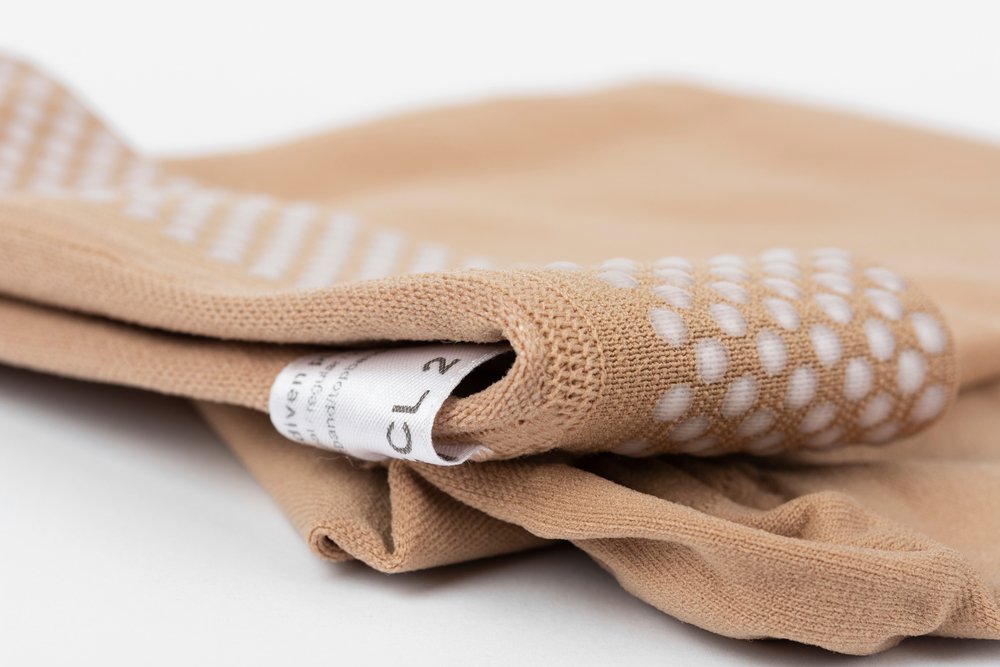Compression stockings are a medical device used for therapeutic and prophylactic purposes for lower limb vascular pathologies. Currently, in specialized stores there is a huge range of these products, differing in the degree of compression, material, method of weaving fabrics and so on. In this article we will talk about what compression stockings are used for, how to choose and wear them correctly.
What are compression stockings?
Compression hosiery is a specific type of fabric product that has a special weaving technique designed to optimally distribute blood pressure, venous or lymphatic outflow in the legs.
First of all, compression stockings differ depending on the material from which they are made. There are products made of microfiber, elastane, and so on.
The stockings are distinguished by their round or flat knitting. In addition, they can have an open or closed toe.
All compression stockings are divided into four compression classes, from the lightest to the most intense.
Depending on the purpose, it is customary to distinguish between:
- Prophylactic knitwear – has a low degree of compression, can be used without consulting a doctor.
- Therapeutic knitwear – has different levels of pressure in different parts of the legs, used to treat varicose veins and other pathologies, used only on prescription by a doctor.
- Hospital knitwear – shown to people who have been prescribed prolonged bed rest after a surgical procedure, with prolonged limb immobility.
Indications and contraindications for prescription

Compression stockings are prescribed for:
- Chronic vein insufficiency;
- Lymphedema;
- Varicose vein disease;
- Inflammation of the venous wall;
- Surgeries and in the period of postoperative recovery.
In 2021, scientists from the National Medical Research Center for Surgery named after A.V. Vishnev published a paper that found elastic compression to be an effective and safe means of preventing unwanted surgery. Vishnevsky National Medical Research Center published a paper in which they found that elastic compression is an effective and safe means of preventing adverse events, complications, and pain in patients after superficial vein surgery for varicose veins in the lower extremities.
In addition, this product can be used for preventive purposes during pregnancy and after childbirth, with active sports, predisposition to vein disease.
As for contraindications, they include various skin and soft tissue pathologies in the leg area, peripheral artery disease, diabetes mellitus, severe deformities of the lower extremities, and so on.
Choosing and wearing compression stockings
The first thing to do is to choose the right size. To this end, you should measure your ankles, shins and hips in the morning without getting out of bed.
Also, when choosing compression stockings it is extremely important to focus on the compression class that was recommended by the doctor, the service life of the product. It should not be forgotten that the hosiery must be hypoallergenic and wear-resistant.
The duration of therapeutic stockings is determined by the doctor. They should be worn on a bare leg, under no circumstances take other people’s stockings. If there is any lasting discomfort while wearing the hosiery, you should consult a doctor.
Sources
Clinical guidelines on the diagnosis and treatment of chronic vein diseases / Stoyko Y.M., Kirienko A.I., Zatevakhin I.I. et al. // 2018 – №3 Short-term compression therapy in chronic vein disease without trophic disorders: possibilities of compression knitwear / Manjikyan O.P., Chubchenko S.V., Fedorov D.A. et al. // Hospital-substituting technologies: Ambulatory Surgery – 2021 – No. 1
The articles on this site are for information purposes only. The site administrators are not responsible for attempting to apply any recipe, advice or diet, nor do they guarantee that the information provided will help or harm you personally. Be cautious and always consult a doctor or nutritionist!
*All products recommended by thefirstdoc.com are selected by our editorial team. Some of our articles include affiliate links. If you buy something through one of these links, you help us earn a small commission from the seller and thus support the writing of useful and quality articles.





